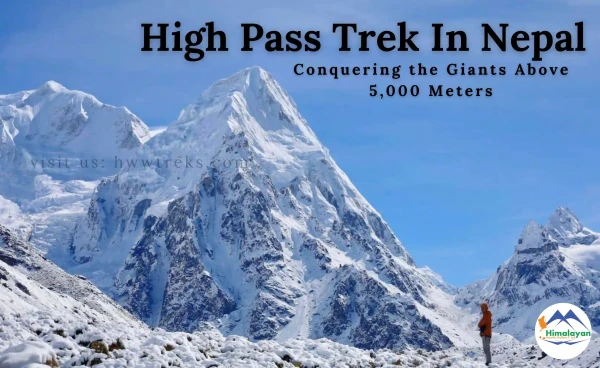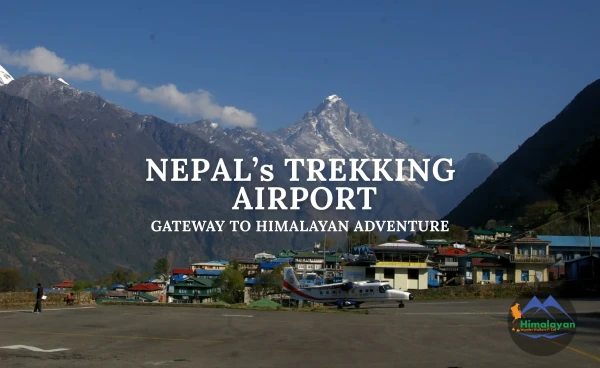- 11/27/2025
- Tags: Trekking in Nepal
- Himalayan Wander Walkers
High Passes Treks in Nepal: Conquering the Giants Above 5000 Meters
Trekking is Nepal's main attraction, but the real adventure begins at high mountain passes above 5,000 meters. Walking along the ancient trade routes, these passes offer awe-inspiring Himalayan views, unique cultural experiences, and untouched wilderness. While Nepal is mostly famous for Mount Everest and the cultural heritage sites, it also has many hidden and unexplored trails that reach 5,000 metres and beyond. Whether you choose the popular Thorong La Pass (5,416m), the challenging Amphu Lapcha Pass (5,845m), or the iconic Everest Three Passes (Kongma La, Cho La, and Renjo La), each one rewards you with magnificent mountain views and remote valleys that feel like paradise.
This comprehensive guide covers everything that you need to know about the high passes above 5,000 meters in Nepal, including the detailed trail routes along with the trekking option, best time to travel, permits needed, some of the interesting gossip that these passes hold, and much more.
Contents [hide]
- Why Trek These High Passes Above 5000 Meters?
- Kongma La Pass (5,535m / 18,159ft)
- Cho La Pass (5,420m / 17,782ft)
- Renjo La Pass (5,360m / 17,585ft)
- Thorong La Pass (5,416m / 17,769ft)
- Larkya La Pass (5,106m / 16,752ft)
- Kang La Pass (5,306m / 17,408ft)
- Mesokanto Pass (5,099m / 16,728ft)
- Tashi Lapcha Pass (5,755m / 18,881ft)
- Amphu Lapcha Pass (5,845m / 19,177ft)
- Ganja La Pass (5,106m / 16,752ft)
- Dhampus Pass (5,258m / 17,251ft)
- Nagdalo La Pass (5,350 m/ 17,552 ft)
- Numa La Pass (5,310m / 17,421 ft)
- Baga La Pass (5,070m / 16,634 ft)
- Jeng La Pass (5,100 m / 16,732 ft)
- Saldang La Pass ( 5,200 m/17,060 ft)
- Best Time to Visit High Passes in Nepal
- Important Permit Regulations
- Here are essential tips for trekkers attempting high passes above 5,000 meters in Nepal
- Conclusion
Why Trek These High Passes Above 5000 Meters?
 These high-altitude passes in Nepal offer more than just bragging rights. They provide an authentic Himalayan experience, taking you away from crowded main trails into remote wilderness. Here are some of the reasons why you should choose these treks instead of normal trekking trails:
These high-altitude passes in Nepal offer more than just bragging rights. They provide an authentic Himalayan experience, taking you away from crowded main trails into remote wilderness. Here are some of the reasons why you should choose these treks instead of normal trekking trails:
- Very few people choose these high passes, so there is solitude and a silence that really feels like being in a mountain region.
- The panoramic 360 views of mountains, valleys, and sunrise that paint the entire Himalaya gold, pink, and blazing orange.
- Experience the culture, tradition, and communities that shape the mountains, and enjoy their hospitality and practical wisdom about weather, terrains, and also about life
- Document the flora and fauna of the region, including the Himalayan tahr, snow leopards (if you're lucky)
Notes: In a world that's increasingly comfortable, safe, and predictable, high-altitude trekking offers genuine adventure where outcomes aren't guaranteed, but the effort actually determines results, which's becoming priceless. So why not try once?
Kongma La Pass (5,535m / 18,159ft)

The Kongma La Pass is a part of the Everest Three Pass, where it is the highest of the three passes and also the most challenging one. With an elevation of 5,535 meters, this pass lies between Chhukung and Lobuche village of Everest. For this pass, the best direction is recommended from South to North, i.e., from Chhukung village to Lobuche village, passing through the moraines and Kongma La Glacier before reaching the summit. This pass trek is considered to be strenuous, and proper rest before and after the trek is a must.
Highlights of Kongma La Pass Trek
- Spectacular views of Makalu, Ama Dablam, Pumori, and Nuptse
- Close-up views of the massive Nuptse-Lhotse wall
- Experience crossing glacial terrain
- Sense of achievement conquering the highest pass in the region
Interesting Facts About Kongma La Pass
- Kongma La means "Snow Pass" in the local Sherpa language
- It's the least crowded among the three passes
- The pass remains covered in snow for most of the year
- Many trekkers skip this pass due to its difficulty, making it perfect for adventure seekers
- The Kongma La glacier crossing requires careful navigation
Cho La Pass (5,420m / 17,782ft)

The Cho La Pass, situated at an altitude of 5,420m, is the most dramatic part of the Everest Three Pass. This pass is considered to be the most famous among other passes since it connects the Everest Base Camp(5,634m) with the Gokyo Valley. The Cho La Pass trek starts from the Dzongla village, and it takes about 7-8 hours to finally reach the Gokyo valley. The climb can be moderate to challenging, depending on your climbing skills and physical fitness.
Highlights of Cho La Pass Trek
- Stunning views of Cholatse and Lobuche peaks
- Connection between two magnificent valleys
- The turquoise Gokyo Lakes are visible from the descent
- Dramatic landscape changes from rocky to glacial terrain
Interesting Facts about Cho La Pass
- "Cho La" translates to "Pass of the Lake."
- The western side glacier crossing can be dangerous in the afternoon when the ice melts
- Early morning crossings are safest due to frozen conditions
- On clear days, you can see six mountains above 8000 meters
- The pass serves as an ancient trade route between Tibet and Nepal
Renjo La Pass (5,360m / 17,585ft)
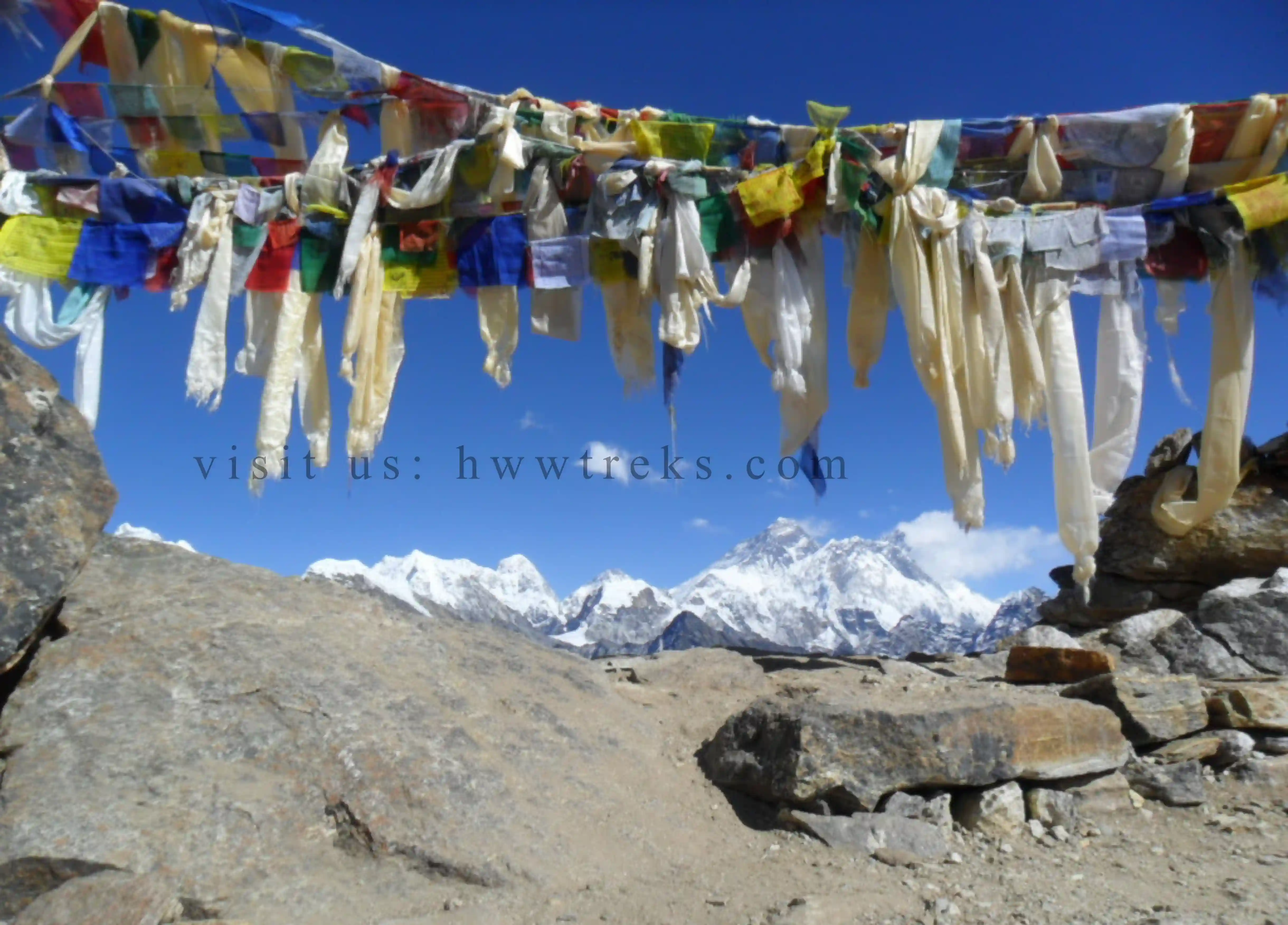 Among the Three Passes, Renjo La is considered to be the easiest one, regardless of the fact that it demands good fitness and acclimatization level. This pass offers a panoramic view of the entire region as it connects the Gokyo Valley with the Thame village of Namche. The Pass trek begins from the Gokyo valley, through the Yak pasture. After 6-7 hours of steady walking with steep descent, the beautiful Thame village is visible.
Among the Three Passes, Renjo La is considered to be the easiest one, regardless of the fact that it demands good fitness and acclimatization level. This pass offers a panoramic view of the entire region as it connects the Gokyo Valley with the Thame village of Namche. The Pass trek begins from the Gokyo valley, through the Yak pasture. After 6-7 hours of steady walking with steep descent, the beautiful Thame village is visible.
Highlights of Renjo La Pass Trek
- 360-degree panoramic mountain views
- Stunning sunrise views over Everest, Lhotse, and Makalu
- View of the entire Gokyo Lake system from above
- Traditional Sherpa villages on the descent
- Less technical terrain compared to other passes
Interesting Facts About Renjo La Pass
- The name "Renjo" means "high place" in the Sherpa language
- You can see four of the world's six tallest mountains from the top
- Best sunrise viewpoint among all three passes
- The trail was used by Sherpas for trading salt and goods with Tibet
- Wildlife like the Himalayan tahr and musk deer are occasionally spotted on this route
- The pass offers the most extended mountain panorama of the three
Maps & Navigation
All three passes (Kongma La, Cho La, and Renjo La) are located in the Sagarmatha National Park of Solukhumbhu district. Most trekkers do all these three passes together, naming them The Everest Three Pass Trek, or if you prefer to then you can do it separately. The circuit usually starts from Lukla, passing the Kongma La first and then Cho La and Renjo La at the end. This move is usually considered an anti-clockwise direction preferred by most trekkers for better acclimatization. Whereas these trekking trails can be customizable according to needs and requirements.
Permit Required for Three Pass Trek
For the Everest Three Pass (Kongma La Pass, Cho La Pass, and Renjo La Pass), you need to have two permits such as:
- Khumbhu Passang Lhamu Rural Municipality Permit
- Sagarmatha National Park Permit
These two permits are compulsory for trekkers going for the three pass trek. One can obtain these permits from Government-registered Trekking and Tour operators in Kathmandu or in Pokhara. Read in detail about trekking permits in the Everest region.
For a detailed itinerary, read here.
Thorong La Pass (5,416m / 17,769ft)
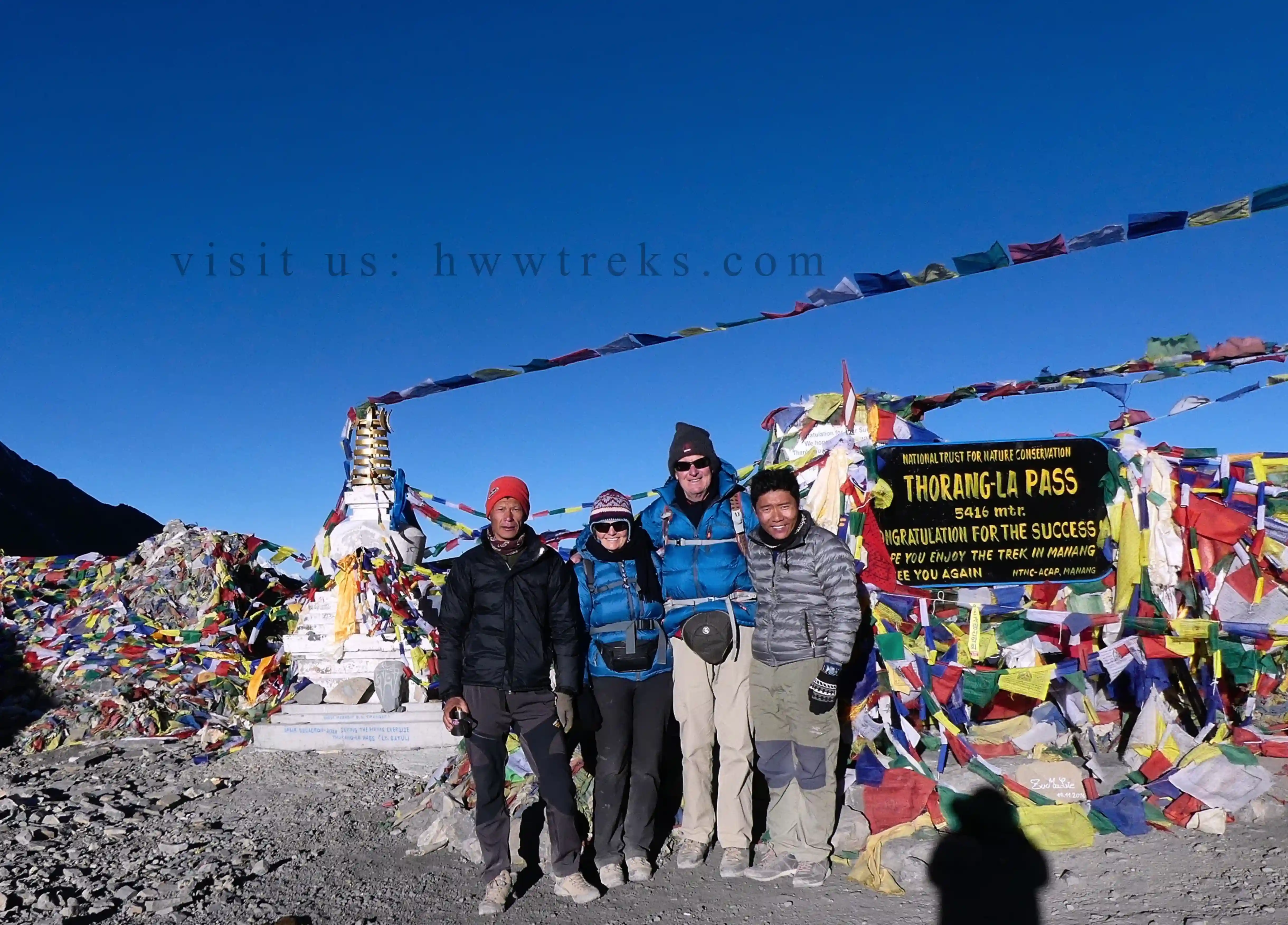 Thorong La Pass (5,416m/17,769ft) is the most famous high-altitude pass above 5000 meters in Nepal and acts as a gateway between the Manang Valley and the Mustang Region. Annually, thousands of trekkers cross this breathtaking pass, making it the most demanding high mountain pass. This pass is the highlight of the famous Annapurna Circuit Trek, which is a combination of physical challenges along with cultural immersion, diverse landscape, and awe-inspiring mountain scenery. For the Thorong La Pass, the trek starts from the Thorong Phedi or High Camp and ends at Muktinath, a sacred Hindu and Buddhist pilgrimage site.
Thorong La Pass (5,416m/17,769ft) is the most famous high-altitude pass above 5000 meters in Nepal and acts as a gateway between the Manang Valley and the Mustang Region. Annually, thousands of trekkers cross this breathtaking pass, making it the most demanding high mountain pass. This pass is the highlight of the famous Annapurna Circuit Trek, which is a combination of physical challenges along with cultural immersion, diverse landscape, and awe-inspiring mountain scenery. For the Thorong La Pass, the trek starts from the Thorong Phedi or High Camp and ends at Muktinath, a sacred Hindu and Buddhist pilgrimage site.
Highlights of Thorong La Pass
- From the prayer flag-decorated summit, enjoy 360-degree panoramas of the Annapurna range, Gangapurna, Tilicho Peak, and Dhaulagiri (the 7th-highest mountain)
- Visit Buddhist monasteries in Manang and Braga, and Muktinath Temple
- Meet Gurung, Thakali, and Tibetan communities and witness traditional Tibetan-influenced villages
- Lush subtropical forests to alpine meadows with deep river gorges and terraced fields
Interesting Facts About Thorong La Pass
- "Thorong La" means "pass of the crossing" or "thorny pass."
- Ancient trade route between Tibet and Nepal for centuries
- Pilgrimage path to the sacred Muktinath temple
- Used by traders transporting salt and wool long before modern trekking
Permit Required for Thorong La Pass
For the Thorang La Pass, you only need the Annapurna Conservation Area Permit. These permits can be obtained from Government-Registered Trekking and Tour operators in Kathmandu or Pokhara.
For a detailed itinerary, read here.
Larkya La Pass (5,106m / 16,752ft)
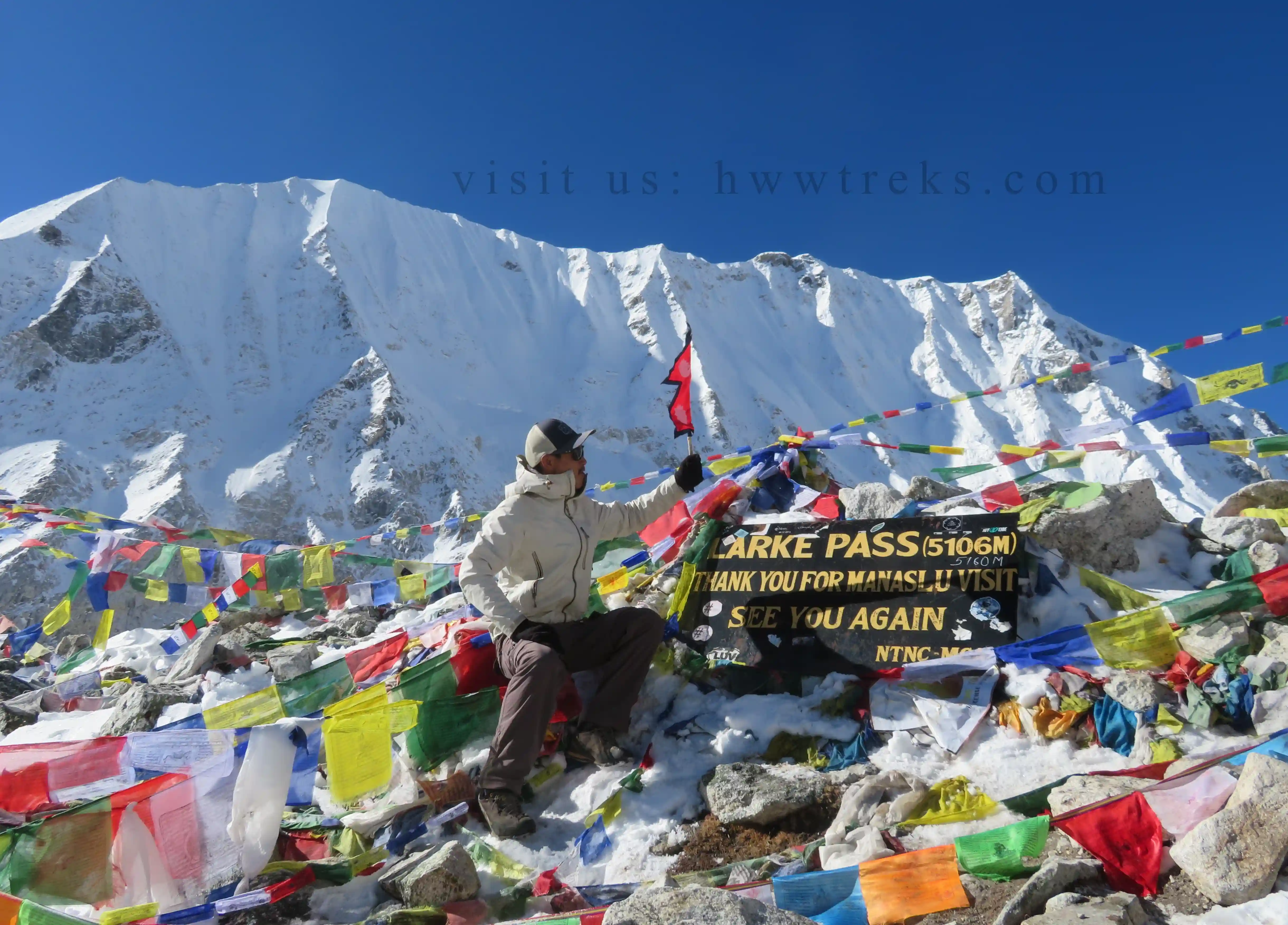
The Larke Pass is one of Nepal’s most challenging and glorious high altitude passes, acting as a gateway between the Manaslu region and the Annapurna Conservation Area. Every year, millions of trekkers cross this pass, which is located beneath Mount Manaslu, the 8th-highest peak in the world. The Larke La Pass is the highlight and best part of the Manaslu Circuit trek, which serves as a perfect mixture of natural beauty with physical challenges, along with a diverse landscape, stunning mountain vistas. The trek to the pass normally starts from the Dharamsala or Larke Phedi and then slowly descends, ending at Bimthang, passing through some of the most remote and beautiful villages.
Highlights of Larke La Pass
- Breathtaking 360-degree panoramas of Mount Manaslu (8th highest mountain at 8,163m), Himlung Himal, and Annapurna II
- Visit ancient Buddhist monasteries and gompas in Lho, Sama Gaun
- Experience the rich Tibetan Buddhist culture
- Witness traditional Tibetan-influenced villages with unique architecture and customs
- Trek through diverse landscapes from lush rhododendron and pine forests to glacial valleys, alpine meadows
Interesting Facts About Larke La Pass
- "Larke La" translates to "pass of the glacier" in the local dialect
- Historic trade route connecting the Nubri Valley with the Marsyangdi Valley, used by traders and herders for centuries
- Part of the restricted area requires special permits
- The Manaslu region remained closed to trekkers until 1991, making it one of Nepal's newer trekking destinations
- The Manaslu Conservation Area, home to endangered species like snow leopards and red pandas
Permit Required for Larkey La Pass
For the Larke La Pass, you need these four different types of permits, such as:
- Manaslu Restricted Area Permit
- Manaslu Conservation Area Permit
- Annapurna Conservation Area Permit
- Entrance Fee By Local Government
All these permits have their own purpose and are compulsory for trekkers going for the Larke La Pass trek or the Manaslu Circuit Trek. One can obtain these permits from Government-registered Trekking and Tour operators in Kathmandu or in Pokhara. Read in detail about trekking permits in the Manaslu region.
For a detailed itinerary, read here.
Kang La Pass (5,306m / 17,408ft)
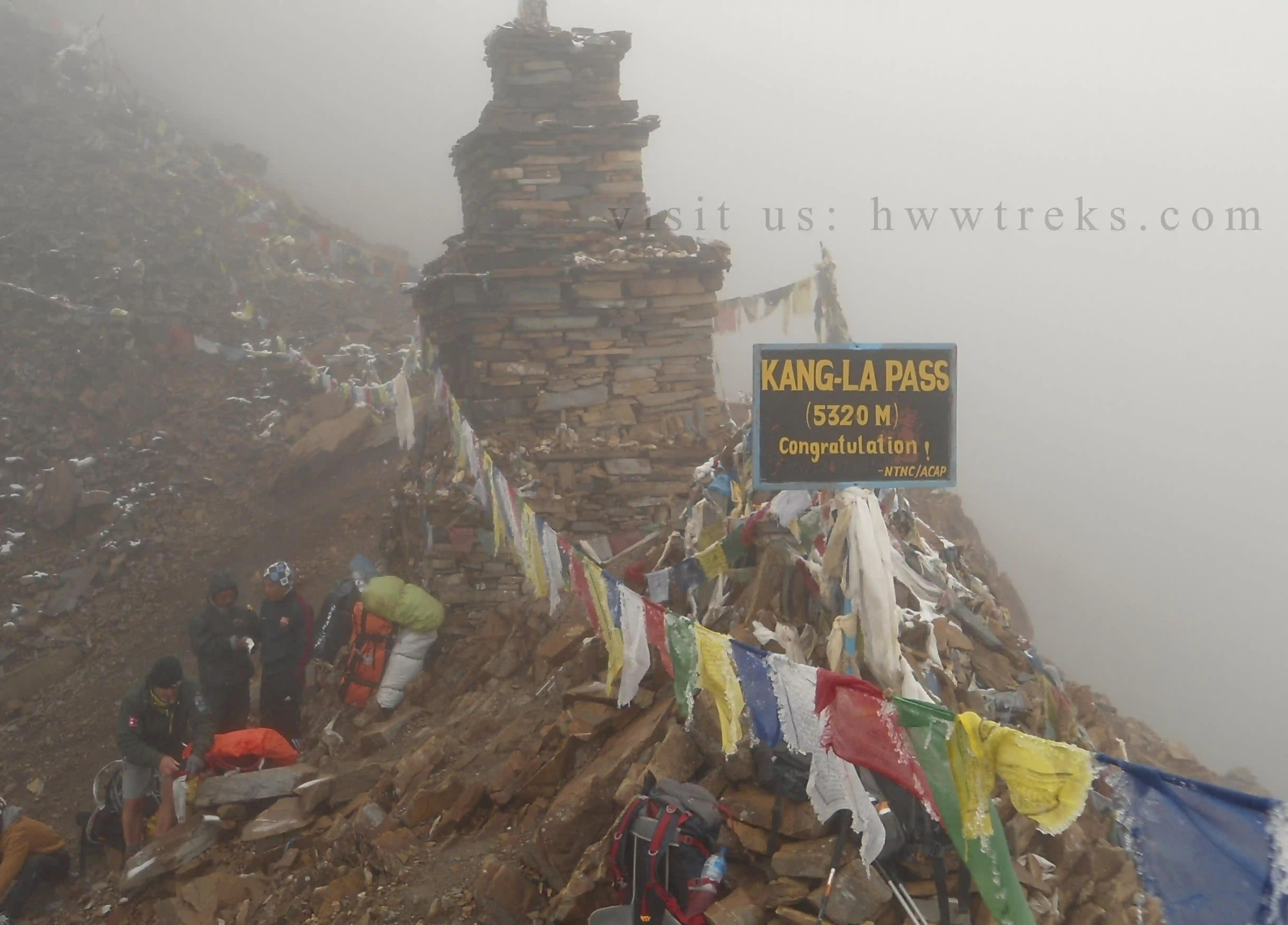
The Kang La Pass is one of the least-traveled trekking passes in the Annapurna region because of its challenges and being new to the people. It serves as a route between the sacred Tilicho Lake area and the Nar Phu Valley. Crossing this pass required you to have climbing and mountaineering skills. You need to have proper trekking and climbing equipment, including crampons, a harness, an ice axe, and so on. The crossing of Kang La Pass is typically done from Nar village, and the ascent takes 6-8 hours through progressively steeper terrain, culminating in a technical climb up snow and ice slopes. The descent to Tilicho Base Camp takes 4-6 hours through challenging loose rock and scree. Many trekking groups establish a high camp below the pass to break the crossing into two days. The pass is part of the Nar Phu Valley and Tilicho Lake Trek, which is considered one of the most comprehensive and challenging trekking routes. One can customize the trek route and break the itinerary according to their preferences and needs.
Highlights of Kang La Pass Trek
- Jaw-dropping 360-degree panoramic views of some of the world's most impressive peaks, including Annapurna Range, Gangapurna (7,455m), Tilicho Peak (7,134m)
- Visit one of the highest lakes (Tilicho Lake) in the world at 4,919 meters
- Visit ancient Buddhist monasteries, including Tashi Lhakhang Gompa in Phu (over 900 years old), Nar Phedi Monastery, and many more
- Witness Himalayan wildlife including blue sheep (bharal) in large herds, Himalayan marmots, snow leopards (in rare cases), Himalayan tahr, golden eagles, and lammergeiers (bearded vultures)
Interesting Facts About Kang La Pass
- The term “Kang La” means “snow pass” in the Tibetan Local dialect
- Kang La Pass is one of the most exclusive passes, with just a few hundred hikers successfully crossing it each year, compared to tens of thousands who traverse Thorong La.
- Local Buddhist communities consider the pass sacred, and prayer flags, cairns, and offerings at the summit reflect the spiritual importance of high mountain passes
- The Pass is highly weather dependent
- This pass requires a special restricted area permit
- Kang La provides the most direct route between the Nar Phu Valley and Tilicho Lake
Permits Required for Kang La Pass Trek
To trek in the Nar Phu Valley and cross Kang La Pass, you need the following permits:
- Nar Phu Special Restricted Area Permit
- Annapurna Conservation Area Permit (ACAP)
These permits are compulsory for trekkers going for the Kangla La Pass trek. The cost of these treks fluctuates during peak season and may vary from September to November and from December to August. One can obtain these permits from Government-registered Trekking and Tour operators in Kathmandu or in Pokhara.
For a detailed itinerary, read here.
Mesokanto Pass (5,099m / 16,728ft)
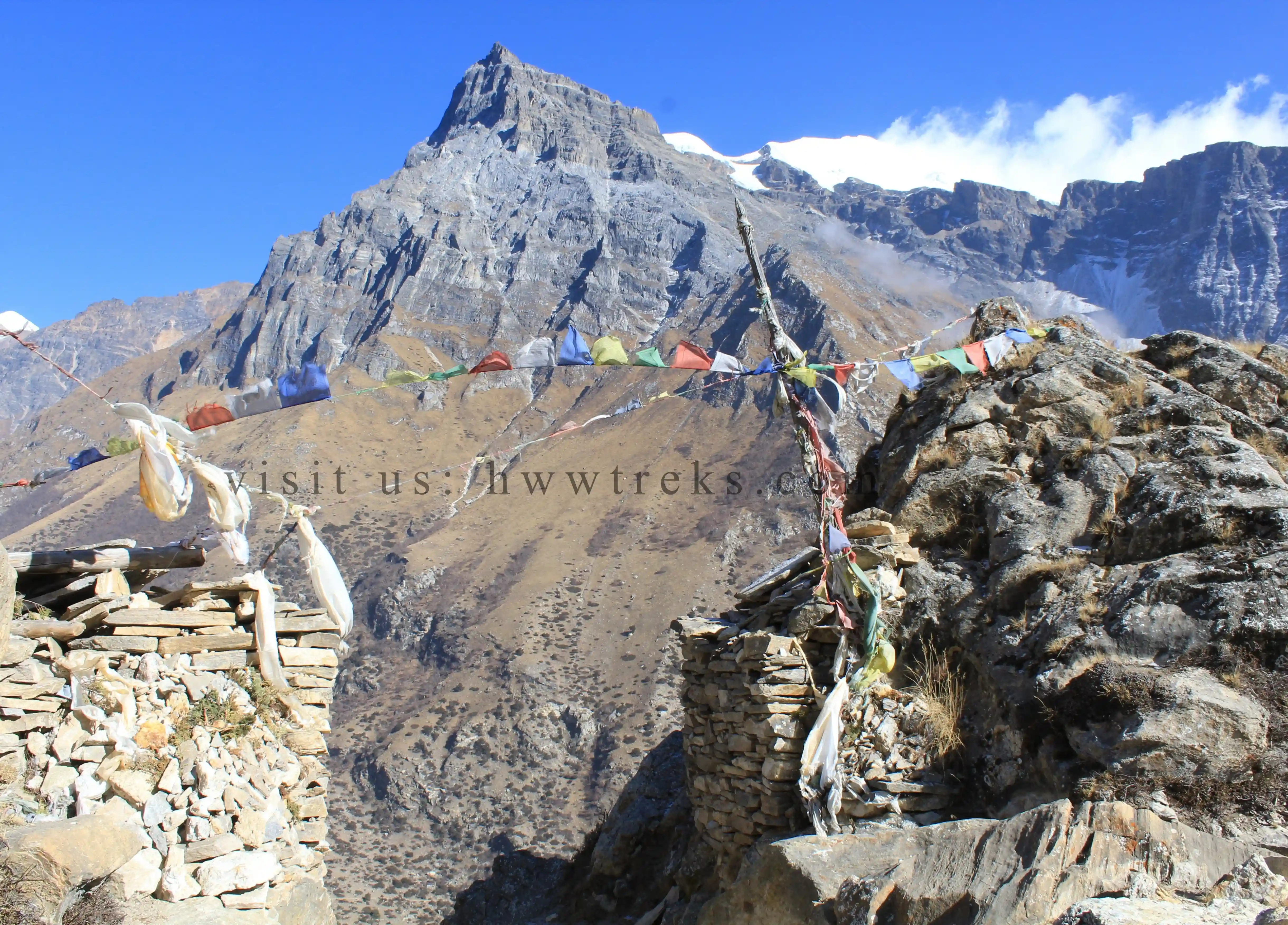
The dramatic alternative route on the Nar Phu Valley trek lies the Mesokanto Pass that connects the Nar Valley with the Manang Valley. Located at the heart of Annapurna Conservation Area, this breathtaking pass is one of Nepal’s least crossed passes due to its incredibly remote and challenging route. Crossing the pass demands high physical strength along with mountaineering and climbing skills, such that one needs to work with trekking and climbing equipment, including ice axes, crampons, a harness, etc. The crossing of Mesokanto Pass itself usually begins from Nar village early in the morning. The ascent takes approximately 5-6 hours through steep rocky terrain and potential snow fields. The descent to Ngawal or Manang takes another 5-6 hours through equally challenging terrain.
Highlights of Mesokanto Pass Trek
- Witness stunning 360-degree views of Annapurna Ranges, Gangapurna (7,455m), Tilicho Peak (7,134m), Pisang Peak, and the Chulu massif
- Explore authentic Tibetan Buddhist culture, architecture, and traditions of Nar Village
- Visit ancient Buddhist monasteries, including Tashi Lhakhang Gompa in Phu village (one of the oldest in the region) and Nar Phedi Monastery
- Observe rare Himalayan wildlife, including blue sheep (bharal), Himalayan marmots, snow leopards (if extremely lucky), mountain goats, and various high-altitude bird species
- Enjoy the rare experience of trekking for days without encountering other trekkers, experiencing true wilderness solitude
Interesting Facts About Mesokanto Pass
- “Mesokanto” means “beautiful crossing “ or “middle pass” in the local dialect
- This pass was used for centuries by traders, herders, and pilgrims traveling between the Nar Phu Valley and Manang, transporting salt, wool, grains, and livestock
- This pass requires a special restricted area permit
- The pass remained virtually unknown to the outside world until the Nar Phu Valley opened to foreign trekkers in 2002, making it one of the last discovered major passes in Nepal
Permits Required for Mesokanto Pass Trek
To trek in the Nar Phu Valley and cross Mesokanto Pass, you need the following permits:
- Nar Phu Special Restricted Area Permit
- Annapurna Conservation Area Permit (ACAP)
These permits are compulsory for trekkers going for the Mesokanto Pass trek. The cost of these treks fluctuates during peak season and may vary from September to November and from December to August. One can obtain these permits from Government-registered Trekking and Tour operators in Kathmandu or in Pokhara.
For a detailed itinerary, read here.
Tashi Lapcha Pass (5,755m / 18,881ft)

Tashi Lapcha Pass is one of the most demanding and iconic trails that connects the remote Rolwaling Valley with the legendary Khumbhu region. This pass is one of the highest and most challenging trekking passes in Nepal, and unlike other passes, it demands good fitness and determination along with technical climbing skills and proper equipment. The crossing of Tashi Lapcha Pass is typically done as part of a three-week expedition that combines the remote beauty of Rolwaling with the iconic attractions of the Everest region. Most trekkers approach from the Rolwaling side, climbing up to the pass from the west and descending into the Khumbu valley to the east, though the route can be done in reverse.
Highlights of Tashi Lapcha Pass Trek
- Experience absolutely breathtaking 360-degree views from the pass summit, including Mount Everest (8,849m), Lhotse (8,516m), Nuptse (7,861m), Cho Oyu (8,188m), Makalu (8,485m), Gaurishankar (7,134m), and many more
- Encounter the dramatic contrast between the wild, remote Rolwaling Valley and the famous, culturally rich Khumbu Valley
- Visit one of Nepal's largest and most spectacular glacial Tso Rolpa Lake lakes at 4,580 meters
- Visit traditional Sherpa villages and important Buddhist monasteries
- Trek through one of Nepal's least-visited and most pristine valleys, experiencing true wilderness with minimal tourist infrastructure and authentic mountain culture
Interesting Facts About Tashi Lapcha Pass
- "Tashi Lapcha" translates to "auspicious pass" or "pass of good fortune" in the Sherpa language
- At 5,755 meters (18,881ft), Tashi Lapcha is one of the highest trekking passes in Nepal
- After crossing Tashi Lapcha, trekkers enter the Khumbu valley at Thame
- Only an estimated 100-200 trekkers successfully cross Tashi Lapcha Pass each year
- The pass was first crossed by Western mountaineers in the 1950s and 1960s during early Himalayan expeditions, but it only became a recognized trekking route in the 1980s
Permits Required for Tashi Lapcha Pass Trek
To do the Tashi Lapcha Pass trek, you need to trek through the Rolwaling Valley and continue to Everest Base Camp. So these are the following permits that you need:
- Gaurishankar Conservation Area Permit (GCAP)
- Sagarmatha National Park Entry Permit
- Local Municipality Permits (Gaurishankar Rural Municipality)
The cost of these treks fluctuates during peak season and may vary from September to November and from December to August. One can obtain these permits from Government-registered Trekking and Tour operators in Kathmandu or in Pokhara. Read more about trekking permits in the Rolwaling region.
For a detailed itinerary, read here.
Amphu Lapcha Pass (5,845m / 19,177ft)
 Standing at an elevation of 5,845 meters, Amphu Lapcha Pass is the highest trekking pass in Nepal, connecting the Imja Valley and the Legendary Khumbhu Valley. The pass is considered to be technically demanding yet worth trying once in a lifetime for the sake of the view that one can witness from the top. Since this pass involves advanced technical climbing abilities, substantial mountaineering expertise, rope work ability, correct equipment, and remarkable physical and mental power, one must have some prior mountain or peak climbing experience. What makes Amphu Lapcha particularly remarkable and daunting is the dramatic asymmetry between its two sides. The approach from the south (Imja Valley side) involves a long but relatively moderate glacier trek with gradual elevation gain. However, the northern descent into the Khumbu Valley is shockingly steep and technical. Most people choose to do the Amphu Lapcha Pass first and then extend their trek to Island Peak Climbing. Whereas one can only do the Amphu Lapcha pass alone.
Standing at an elevation of 5,845 meters, Amphu Lapcha Pass is the highest trekking pass in Nepal, connecting the Imja Valley and the Legendary Khumbhu Valley. The pass is considered to be technically demanding yet worth trying once in a lifetime for the sake of the view that one can witness from the top. Since this pass involves advanced technical climbing abilities, substantial mountaineering expertise, rope work ability, correct equipment, and remarkable physical and mental power, one must have some prior mountain or peak climbing experience. What makes Amphu Lapcha particularly remarkable and daunting is the dramatic asymmetry between its two sides. The approach from the south (Imja Valley side) involves a long but relatively moderate glacier trek with gradual elevation gain. However, the northern descent into the Khumbu Valley is shockingly steep and technical. Most people choose to do the Amphu Lapcha Pass first and then extend their trek to Island Peak Climbing. Whereas one can only do the Amphu Lapcha pass alone.
Highlights of the Amphu Lapcha Pass Trek
- Experience absolutely breathtaking 360-degree views of the world's highest peaks, including Mount Everest (8,849m), Lhotse (8,516m - 4th highest), Makalu (8,485m - 5th highest), Cho Oyu (8,188m - 6th highest), Ama Dablam (6,812m), and dozens of other
- Climb Island Peak (Imja Tse, 6,189m), one of Nepal's most popular and achievable 6,000-meter trekking peaks
- Connect the remote and beautiful Imja Valley with the legendary Khumbu Valley,
- Trek across and around enormous glaciers, including the Imja Glacier, Lhotse Glacier, and Khumbu Glacier
- Experience authentic Sherpa culture and visit the spiritual heart of the Khumbu at Tengboche Monastery
Interesting Facts About Amphu Lapcha Pass
- At 5,845 meters (19,177ft), Amphu Lapcha is the highest trekking pass in the Khumbu region
- “Amphu Lapcha” means “Southern Pass” in the Sherpa language
- Only an estimated 50-100 mountaineers successfully cross the Amphu Lapcha Pass each year
- Mobile phone coverage is unreliable or absent in the high areas around the pass
- Helicopter rescue is extremely difficult or impossible at the pass elevation due to thin air and technical terrain
Permits Required for the Amphu Lapcha Pass Trek
For the Amphu Lapcha Pass Trek, you need to have the following permits:
- Sagarmatha National Park Entry Permit
- Khumbu Pasang Lhamu Rural Municipality Permit
- Makalu Barun National Park Permit
These permits are compulsory for trekkers going for the Amphu Lapcha Pass trek. The cost of these treks fluctuates during peak season and may vary from September to November and from December to August. One can obtain these permits from Government-registered Trekking and Tour operators in Kathmandu or in Pokhara.
For a detailed itinerary, read here.
Ganja La Pass (5,106m / 16,752ft)

In the Langtang region, the Ganja La Pass stands at an altitude of 5,106m. This pass connects the charming Langtang region with the sacred Helambhu region of Nepal. During the fearful earthquake of April 2015, the area near the Ganja La pass was hit by massive avalanches, destroying the villages nearby and killing hundreds of residents and trekkers. Since then, the region has been rebuilt with strength, and the trekking in this region adds more meaning as it indirectly supports the local Tamang communities. Crossing the Ganja La pass requires technical skills, proper equipment including crampons and ice axes, rope work in certain sections, and the ability to navigate steep. People usually trek to Langtang Valley and then approach the Ganja La pass, whereas some experienced groups cross from Helambu to Langtang Valley, though this direction involves a more difficult initial ascent and is less frequently attempted.
Highlights of Ganja La Pass Trek
- Enjoy breathtaking panoramic views of Langtang Lirung (7,227m), Dorje Lakpa (6,966m), Langshisha Ri (6,427m), and many more
- Stay in the beautiful high-altitude settlement of Kyanjin Gompa (3,870m), a spiritual and trekking hub surrounded by towering peaks
- Visit traditional villages, ancient Buddhist monasteries, and explore unique architecture
- Trek through remarkably varied landscapes from subtropical forests with rhododendrons, oaks, and bamboo to alpine meadows with yak pastures, to high-altitude deserts, glaciers, and finally back to terraced agricultural lands
- Encounter cheese factories producing the famous Langtang cheese.
Interesting Facts About Ganja La Pass
- In the local Tamang dialect, “Ganja” stands for a local deity, and “La” means pass.
- At exactly 5,106 meters, Ganja La shares its altitude with Larke La Pass in the Manaslu region
- There are no villages or permanent settlements between Kyanjin Gompa and Keldang
- The pass is essentially impossible to cross during the winter months (December-March) due to heavy snowfall, extreme cold, and avalanche danger
Permits Required for Ganja La Pass Trek
To trek in the Langtang region and cross Ganja La Pass, you need the following permits:
- Langtang National Park Entry Permit
- Trekkers' Information Management System (TIMS) Card
- Local Community Permits
These permits are compulsory for trekkers going for the Ganja La Pass trek. The cost of these treks fluctuates during peak season and may vary from September to November and from December to August. One can obtain these permits from Government-registered Trekking and Tour operators in Kathmandu or in Pokhara.
Dhampus Pass (5,258m / 17,251ft)
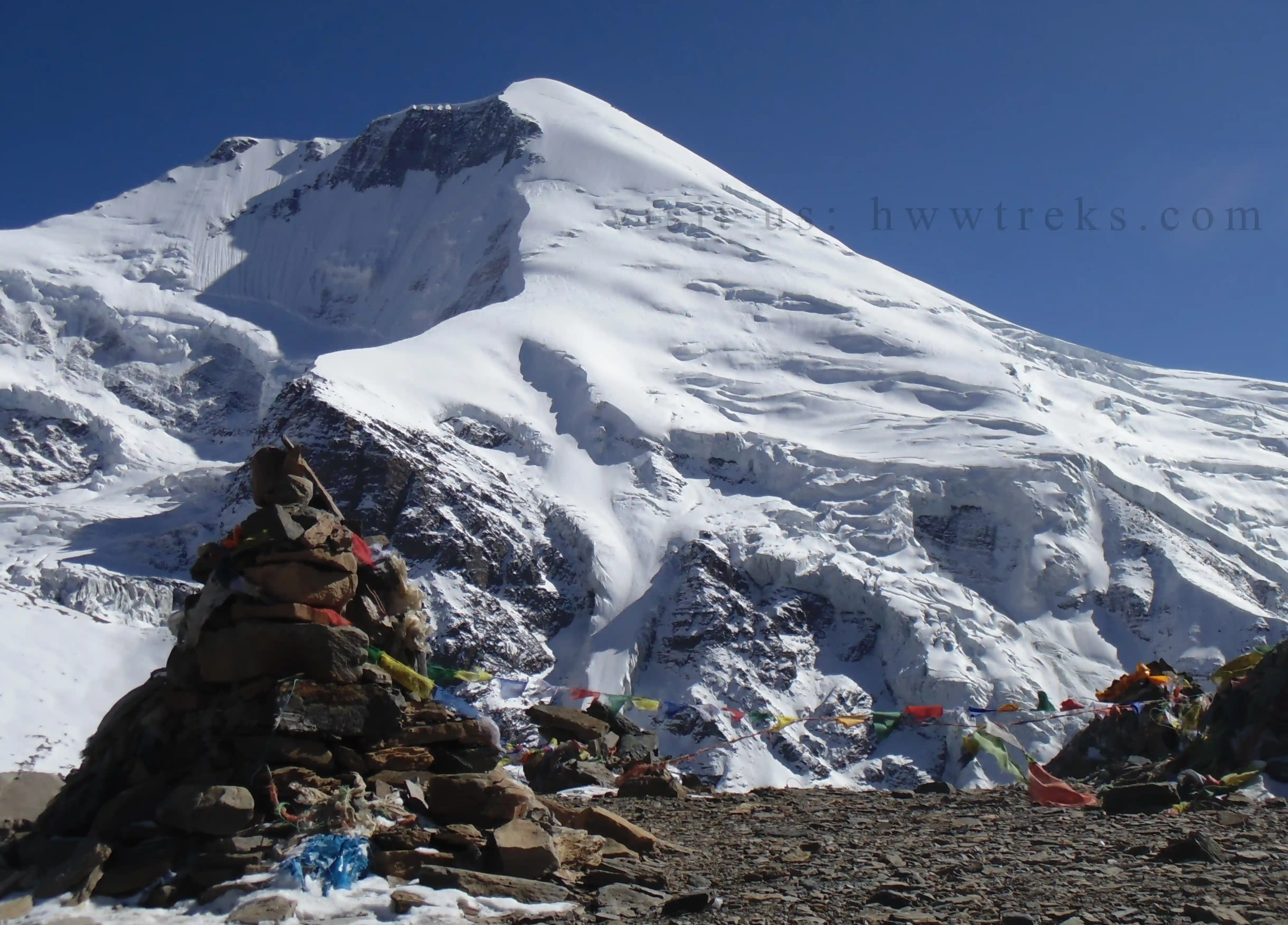
Dhampus Pass, one of the best highlights of the Dhaulagiri Circuit trek, is one of the most challenging and spectacular high-altitude crossings at 5,258 meters. Crossing the pass is technically demanding and requires not just physical fitness but also some mountaineering skills, favourable weather conditions, and proper acclimatization. Dhampus Pass also serves as a connecting bridge between the Dolpo region and the Dhaulagiri massif, providing isolated and snowy mountain vistas. The journey to Dhampus Pass typically begins from either Marpha or Jomsom in the lower Mustang region, travelling through traditional villages, high pastures, and eventually into the higher elevations. Before reaching the Dhampus Base Camp, climbers pass through the dramatic French Pass (5,360m), where one can acclimatize. The trek to the Dhampus Pass starts from Yak Kharka, with a duration of 7-8 hours of continuous walking. The entire trek may take a maximum of 18 days, depending on the need for acclimatization and the trail chosen.
Highlights of the Dhampus Pass Trek
- Close-up views of Dhaulagiri I (8,167m), the world's seventh-highest mountain, along with Tukuche Peak (6,920m), Dhaulagiri II through V, and numerous other peaks above 6,000 meters
- Experience the dramatic contrast between the Upper Mustang and the lush rhododendron forests and apple orchards of the lower valleys
- Trek through ancient trading routes once used by salt traders traveling between Tibet and Nepal
- Encounter blue sheep, Himalayan pheasants, and, if fortunate, glimpse the elusive snow leopard tracks in the higher reaches of the trek
Interesting Facts About Dhampus Pass
- The word "Dhampus" means “Flat place” in the local dialect
- The pass gets through the Italian camp and the Japanese Camp
- This pass is also known as the “Thapa La” pass
- The region receives significantly less annual rainfall than eastern Nepal
Permits Required for Dhampus Pass Trek
To trek through the Dhaulagiri region and cross Dhampus Pass, you need the following permits:
- Annapurna Conservation Area Project (ACAP) Permit
- Trekkers' Information Management System (TIMS) Card
- Local Community Permits
These permits are mandatory for anyone attempting the Dhampus Pass trek. The costs vary between peak trekking seasons (September to November and March to May) and off-season periods. One can obtain these permits from Government-registered Trekking and Tour operators in Kathmandu or in Pokhara.
For a detailed itinerary, read here.
Nagdalo La Pass (5,350 m/ 17,552 ft)
At an altitude of 5,350 meters, there stands one of the challenging high passes of the Dolpo region, the Nagdalo La Pass. Connecting the Shey Phoksundo Lake and the Shey Gompa of Dolpo, this pass serves as a crucial gateway for trekkers while exploring the region. Decorated with colorful prayer flags and treeless terrain, this pass offers a stunning view of the Tibetan Plateau along with the barren mountains. The region near the pass, famous for the ancient Bon Buddhist tradition and the sacred snow leopards.
Highlights of the Nagdalo La Pass Trek
- Witness stunning views of the Dhaulagiri and Annapurna ranges stretching across the horizon
- Pass through ancient settlements and spot blue sheep, Himalayan tahr, and if you're lucky, the elusive snow leopard
- Experience authentic Tibetan Buddhist culture in isolated monasteries and villages along the route
Interesting Fact About Nagdalo La Pass
- Nagdalo La Pass is alternatively known as Kang La Pass
- Local traders have used this pass for centuries as part of the ancient salt trade route between Tibet and Nepal
Permits Required for Nagdalo La Pass
- Upper Dolpo Restricted Area Permit
- Shey Phoksundo National Park Entry Permit
These permits are mandatory for anyone attempting the Nagdalo La Pass trek. The costs vary between peak trekking seasons (September to November and March to May) and off-season periods. One can obtain these permits from Government-registered Trekking and Tour operators in Kathmandu or in Pokhara.
Numa La Pass (5,310m / 17,421 ft)
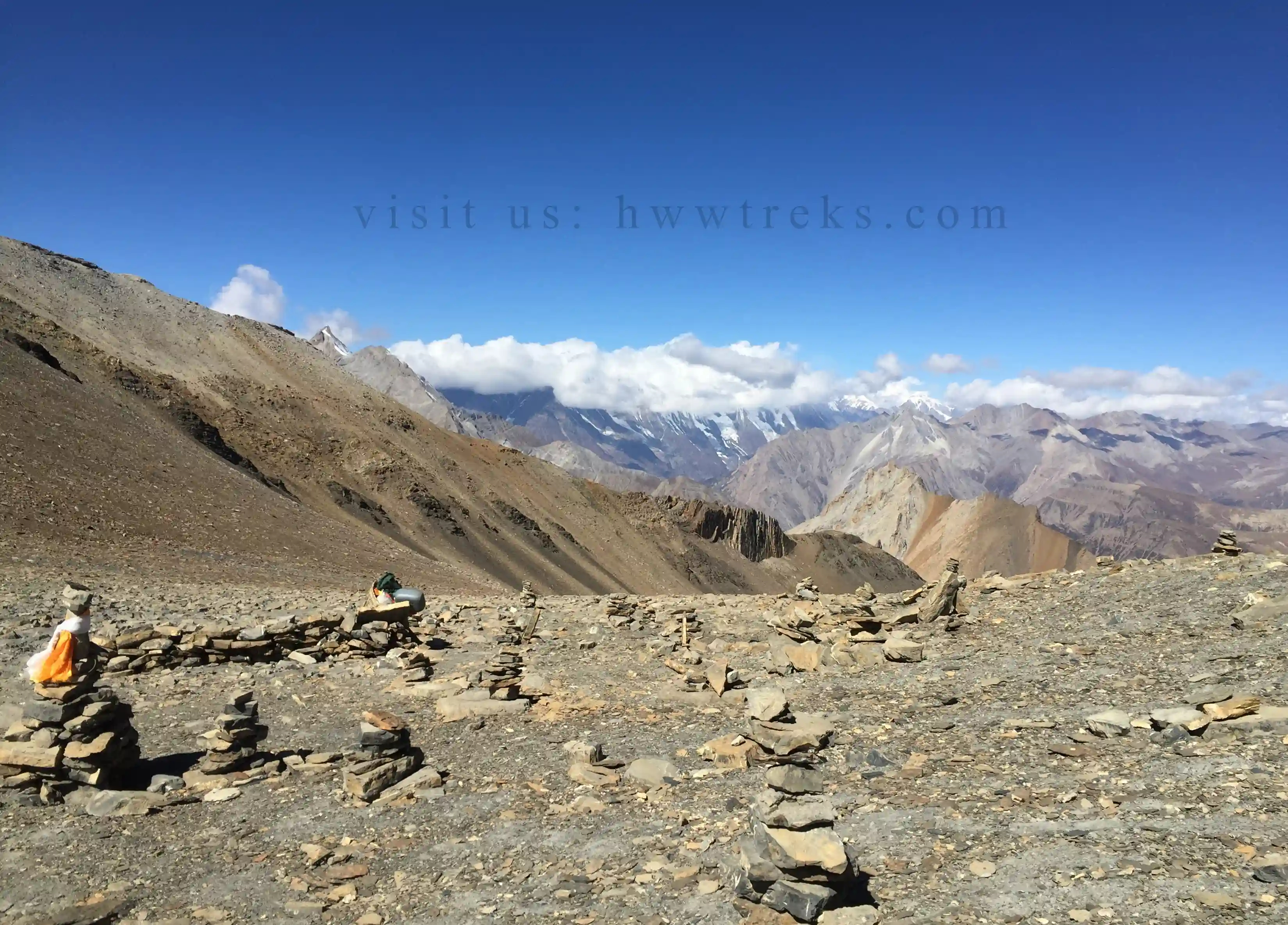 Numa La Pass is a part of the famous Lower Dolpo Circuit trek, where this pass is accompanied by the Baga La Pass (5070m). The combined trek is also known as the “Numa La Baga La Circuit Trek”. The pass is decorated with multiple prayer flags and is connected to the Dho Tarap and leads to the beautiful Shey Phoksundo. Crossing Numa la pass requires proper acclimatization and a good level of physical strength.
Numa La Pass is a part of the famous Lower Dolpo Circuit trek, where this pass is accompanied by the Baga La Pass (5070m). The combined trek is also known as the “Numa La Baga La Circuit Trek”. The pass is decorated with multiple prayer flags and is connected to the Dho Tarap and leads to the beautiful Shey Phoksundo. Crossing Numa la pass requires proper acclimatization and a good level of physical strength.
Highlights of the Numa La Pass trek
- Experience the stark beauty of the Tibetan plateau with its unique desert-like terrain
- Catch glimpses of the stunning turquoise Phoksundo Lake from certain vantage points
- Visit the sacred 11th-century Shey monastery nearby, home to rare Buddhist scriptures
- Experience multi-pass route, both Numa La and Baga La Pass
Interesting Fact About Numa La Pass
- Numa La is known among locals as the "Pass of the North Wind."
- This pass includes the crossing of the Baga La Pass (5070m)
- It's a gateway to the Dho Tarap valley
Permits Required for Numa La Pass
- Upper Dolpo Restricted Area Permit
- Shey Phoksundo National Park Entry Permit
These two permits are mandatory for anyone attempting the Numa La Pass trek. The costs vary between peak trekking seasons (September to November and March to May) and off-season periods. One can obtain these permits from Government-registered Trekking and Tour operators in Kathmandu or in Pokhara.
For a detailed itinerary, read here.
Baga La Pass (5,070m / 16,634 ft)
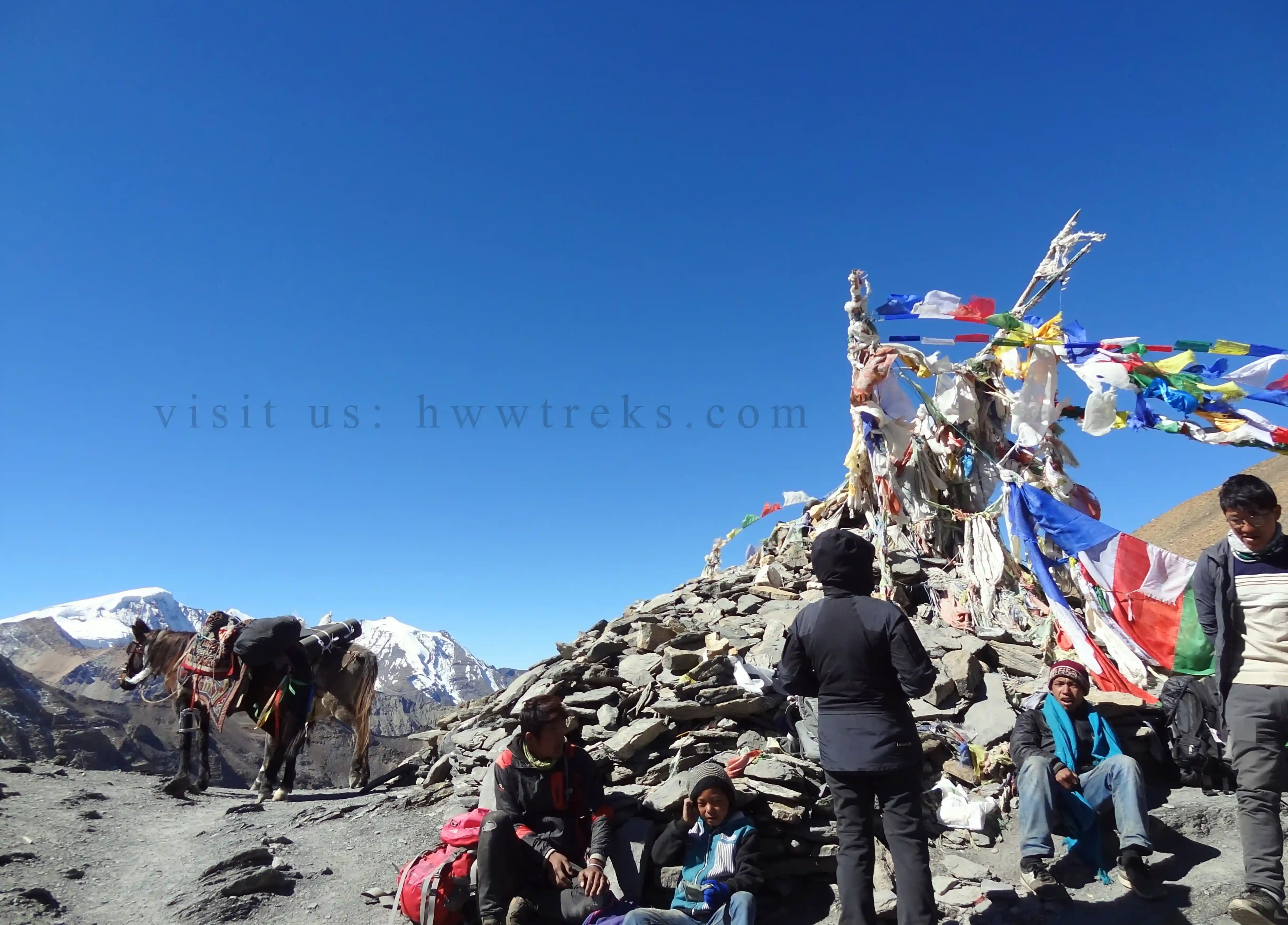 Among the famous passes in the Dolpo region, the Baga La Pass stands at an elevation of 5,070m, forming the famous Numa La Baga La circuit trek. This pass connects the Dho Tarap Valley with the Phoksundo Lake, offering an unforgettable and isolated trekking journey. Along with the Numa La pass, the Baga La pass serves as an ancient trade route between Tibet and Nepal, which is still in use. The pass rewards the panoramic mountain view to the trekkers, eventually ending the pass to the shores of the magnificent turquoise Phoksundo Lake.
Among the famous passes in the Dolpo region, the Baga La Pass stands at an elevation of 5,070m, forming the famous Numa La Baga La circuit trek. This pass connects the Dho Tarap Valley with the Phoksundo Lake, offering an unforgettable and isolated trekking journey. Along with the Numa La pass, the Baga La pass serves as an ancient trade route between Tibet and Nepal, which is still in use. The pass rewards the panoramic mountain view to the trekkers, eventually ending the pass to the shores of the magnificent turquoise Phoksundo Lake.
Highlights of the Baga La Pass Trek
- Trek through the remote and culturally rich Dho Tarap Valley, home to ancient Bon Po traditions and unique Tibetan Buddhist culture
- Enjoy the panoramic views of the Dhaulagiri and Kanjiroba mountain ranges
- Complete the challenging multi-pass circuit, i.e., Baga la and Numa La
- Encounter rare wildlife, including blue sheep, Himalayan wolves, and, if fortunate, the elusive snow leopard in Shey Phoksundo National Park
- Experience the dramatic contrast between barren high-altitude landscapes and lush valley ecosystems within a single trek
Interesting Facts About Baga La Pass
- “Baga La” means “Pass of the Tiger” in the local dialect
- This pass was an ancient crucial salt trading route between Tibet and the Nepal and still occasionally used by local traders
- The descent from the Baga La Pass offers a dramatic view of Phoksundo Lake
- The region around Baga La was virtually closed to outsiders until 1989, preserving its unique culture and pristine environment
Permits Required for Baga La Pass
- Upper Dolpo Restricted Area Permit
- Shey Phoksundo National Park Entry Permit
These two permits are mandatory for anyone attempting the Numa La Pass trek. The costs vary between peak trekking seasons (September to November and March to May) and off-season periods. One can obtain these permits from Government-registered Trekking and Tour operators in Kathmandu or in Pokhara.
Jeng La Pass (5,100 m / 16,732 ft)
Among the other high passes in the Dolpo region, Jeng la is relatively lower, connecting the Tarap valley with a remote settlement near the Shey Phoksundo. Despite being at a lower elevation as compared to other passes, Jengja Pass still holds challenges due to steep ascent and unpredictable weather. It is known for being a combination of technical difficulties and untamed beauty. The approach to Jeng La takes through a landscape of sublime desolation, rocky wilderness, where prayer flags adorn the summit. From the top, trekkers are rewarded with magnificent vistas of the surrounding peaks and the sprawling, arid valleys that define this rain-shadow region.
Highlights of Jeng La Pass Trek
- Walk in the footsteps of traders who have crossed this pass for generations
- Experience the dramatic change from sparse vegetation to completely barren land as you gain altitude
- Meet local shepherds, capture the raw, unfiltered beauty of one of Nepal's most remote regions
- Enjoy solitude and true nature with fewer crowds
Interesting Fact About Jeng La Pass
- Jeng La has several hidden caves along its route that were historically used by Tibetan yogis and hermits for meditation retreats
- The pass was once used as a trading route between Tibet and Upper Dolpo
- Crossing the pass offers an awe-inspiring vista of Kangiroba and the Dhaulagiri range
Permits Required for Jeng La Pass
- Upper Dolpo Restricted Area Permit
- Shey Phoksundo National Park Entry Permit
These permits are mandatory for anyone attempting the Jeng La Pass trek. The costs vary between peak trekking seasons (September to November and March to May) and off-season periods. One can obtain these permits from Government-registered Trekking and Tour operators in Kathmandu or in Pokhara.
Saldang La Pass ( 5,200 m/17,060 ft)
Saldang La stands at 5,200 meters and is named after Saldang village, one of the highest and largest settlements in Dolpo. This pass is significant because it provides access to Saldang, a culturally rich village that has maintained its traditional Tibetan Buddhist lifestyle for centuries. The pass offers trekkers a genuine glimpse into how people survive and thrive in one of the world's most challenging environments.
Highlights of the Saldang La Pass Trek
- Visit one of the highest inhabited villages in the world with around 400 residents
- Experience a village, see traditional flat-roofed houses made of stone and mud, perfectly adapted to the harsh climate
- witness colorful Buddhist festivals with masked dances and ceremonies
- Observe how locals grow barley and buckwheat at extreme altitudes using ancient farming techniques
Interesting Fact About Saldang La Pass
- Saldang La and the village of Saldang were featured in the famous book and film "The Snow Leopard" by Peter Matthiessen
- The village still operates a community-owned lodge where profits are shared among villagers
- The pass is home to the Gomoche Monastery (founded in the 12th century), and the Shelri Sumdho Monastery (mid-16th century)
Permits Required for Saldang La Pass
- Upper Dolpo Restricted Area Permit
- Shey Phoksundo National Park Entry Permit
These permits are mandatory for anyone attempting the Saldang La Pass trek. The costs vary between peak trekking seasons (September to November and March to May) and off-season periods. One can obtain these permits from Government-registered Trekking and Tour operators in Kathmandu or in Pokhara.
Best Time to Visit High Passes in Nepal
 Trekking over 5,000 meters in elevation should be planned and researched properly. At such extreme altitudes, altitude sickness may arise along with many other serious problems, including severe headaches, nausea, shortness of breath, and in extreme cases, life-threatening conditions. The timing of your trek plays a crucial role in ensuring safety and success. Here's a comprehensive guide to help you choose the best time for your adventure.
Trekking over 5,000 meters in elevation should be planned and researched properly. At such extreme altitudes, altitude sickness may arise along with many other serious problems, including severe headaches, nausea, shortness of breath, and in extreme cases, life-threatening conditions. The timing of your trek plays a crucial role in ensuring safety and success. Here's a comprehensive guide to help you choose the best time for your adventure.
Spring Season (March to May) - BEST TIME
Spring is considered to be one of the best seasons for trekking in Nepal. During these months, the weather becomes suitable and stable with clear skies with excellent visibility of mountains and blooming Rhododendrons along the trail at lower elevations. This is peak trekking season, so while trails are busier, you'll benefit from well-established routes, open tea houses, and a strong support network of fellow trekkers and guides. The temperatures are warmer as compared to winter, and there will be fewer chances of altitude sickness, and crossing the high passes will be comfortable and safer.
Autumn Season (September to November) - BEST TIME
Autumn is the most popular trekking season in Nepal, where the weather remains stable and dry with minimal rain, creating perfect conditions for high-altitude trekking. During this season, the air becomes clear, providing clear visibility of mountains and peaks. Daytime temperatures are comfortable, though nights can be cold at higher elevations.
Winter Season (December to February) - NOT RECOMMENDED
Winter in Nepal brings heavy snow to freezing temperatures in the mountain region, and these transform the trekking in that region extremely challenging and threatening. Heavy snowfall blocks many passes completely, while those that remain accessible carry severe avalanche risks. Most tea houses and lodges close for the season, leaving trekkers without shelter or support along the route.
Monsoon Season (June to August) - NOT RECOMMENDED
The monsoon season brings heavy rainfall to most of Nepal, creating hazardous trekking conditions throughout the country. Continuous rain triggers frequent landslides and makes trails slippery and dangerous, particularly on steep ascents and descents. However, the rain-shadow regions of Upper Mustang and Dolpo remain accessible as they receive minimal rainfall. For most high passes in the Everest, Annapurna, Manaslu, and Langtang regions, the monsoon season should be completely avoided.
Recommended: Plan your high pass trek during late March to May or September to November for the safest and most enjoyable experience. Always ensure proper acclimatization, hire experienced guides, carry adequate insurance, and prepare thoroughly for the physical and mental challenges of high-altitude trekking.
Important Permit Regulations
- Minimum Group Size: At least 2 trekkers required (though some agencies may require larger groups)
- Licensed Guide Mandatory: Must trek with a government-licensed guide; independent trekking is prohibited
- Registered Agency: All permits must be processed through a Nepal government-registered trekking agency
- Passport Validity: Bring a passport that has a validity of 6 months
- Passport Copy: Valid passport copy required for all permits
- Top Tips for crossing high passes above 5k in Nepal
Here are essential tips for trekkers attempting high passes above 5,000 meters in Nepal
- Prioritize acclimatization, take mandatory rest days and let your body adjust the altitude. Never rush your ascent, and always include extra acclimatization days in your itinerary.
- Always hire an experienced and licensed guide, since they will navigate through the technical section safely and will make crucial decisions.
- Pack your specialized essentials and back light
- Keep yourself physically fit and train 3-4 months before the trek
- Check Weather and Start Early
- Get proper travel and trekking insurance that provides emergency helicopter evacuation
- Respect the Mountain
Conclusion
Trekking and crossing these passes high above 5,000 meters offers long-lasting memories along with unique natural beauty and cultural immersion. Whether you are aiming for the Everest Three Pass or the popular Thorongla Pass, or the most challenging Amphu Lapcha Pass, each pass is unique in its own way with its own specialty. They all have some very unique and unforgettable stories and journeys to offer to the trekkers. Therefore, with proper planning of gears, season, and weather, one will get to enjoy the best version of these passes and will be rewarded with majestic beauty that makes Nepal the world's top high-altitude trekking destination.
Read a similar useful blog regarding trekking and travelling to Nepal and its region:
- Everything you need to know about the Kanchenjunga Trek
- Manaslu Trekking and Tips
- Upper Mustang Trekking Guide
- Tiji Festival of Upper Mustang
- Tsum Valley Trek Guide
- Rolwaling and Lapche Valley Guide
- An essential guide and Top Tips for trekking in the Dolpo Region of Nepal
- Everest Base Camp Trek Guide
- Best Treks in Nepal: Highly Recommended Treks
- My Inner Dolpo Trek Experience
- Shyagya Tradition of Tsum Valley
- Airports of Nepal
- My North Annapurna Base Camp Trek Experience
Frequently Asked Questions
Find answers to common questions about our services
Amphu Lapcha Pass at 5,845 meters (19,177ft) is the highest trekking pass in Nepal. It connects the Imja Valley with the Khumbu Valley and requires advanced technical climbing skills, proper mountaineering equipment, including ropes and crampons, and previous high-altitude experience. Only 50-100 trekkers successfully cross it annually due to its extreme difficulty and technical demands.
Yes, the high passes trek can be customized to meet your needs. We can modify the itinerary based on your preferences, whether you want to shorten or extend the trek or add extra rest days, or any side trips. Just let us know what you're looking for, and we’ll be happy to accommodate your wishes: “Customize Your Trip.”
Renjo La Pass at 5,360 meters is considered the easiest among high passes above 5000m, particularly within the Everest Three Passes circuit. Despite being "easier," it still demands excellent physical fitness, proper acclimatization, and suitable gear.
While trekking at high elevations, altitude sickness is the main risk, where one can suffer from acute mountain sickness (AMS), high altitude pulmonary edema (HAPE), and high altitude cerebral edema (HACE). Proper acclimatization, slowing down the climb, and listening to the guide are the major safety measures that can be applied.
No, you cannot trek without a guide in these high passes. You must hire a government-licensed guide and trek with at least one other person (minimum group size of 2). You should get your permits from a government-licensed trekking and tour operator.
During trekking in high passes, you should be fit enough to walk 6-8 hours daily comfortably. Therefore, train yourself 3-4 months before with short hiking or running, and an elevation gain workout.
Yes, in most routes, such as Thorong La and the Everest Three Passes, there are well-established tea houses. Whereas in remote places like Tashi Lapcha, Amphu Lapcha, and most of Dolpo’s passes, camping is required.
Renjo La Pass (5,360m) offers arguably the best panoramic mountain views, showcasing four of the world's six tallest peaks, including Everest(8,848m), Lhotse(8,516m), Makalu(8481m), and Cho Oyu(8,188m), plus the entire Gokyo Lake system. However, each pass offers unique perspectives: Kongma La provides dramatic Nuptse-Lhotse wall views, while Thorong La showcases the complete Annapurna range. View quality depends on weather conditions.
No questions found matching your search. Try different keywords or browse all questions above.

